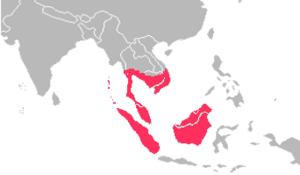Greater mouse-deer facts for kids
Quick facts for kids Greater mouse-deer |
|
|---|---|
 |
|
| Conservation status | |
| Scientific classification | |
| Genus: |
Tragulus
|
| Species: |
napu
|
 |
|
The greater mouse-deer, also known as the greater Malay chevrotain or napu (Tragulus napu), is a fascinating animal. It's an even-toed ungulate, which means it walks on hooves with an even number of toes. Even though it looks a bit like a tiny deer, it actually belongs to its own special family called Tragulidae.
You can find these shy creatures in the warm, wet forests of places like Sumatra, Borneo, and other smaller islands in Malaysia and Indonesia. They also live in southern Myanmar, southern Thailand, and peninsular Malaysia. Their favorite home is in moist, lowland forests.
Contents
What's in a Name?
The scientific name Tragulus comes from two words. Tragos is a Greek word meaning "goat," and –ulus is a Latin ending that means "tiny." So, Tragulus means "tiny goat"! The name Napu is a local name from the Malay language.
People call it a "mouse-deer" because it's so small, not because it's related to mice or true deer. It's called "greater" because it's bigger than other types of mouse-deer in its family.
How the Greater Mouse-Deer Looks
The greater mouse-deer is quite small for an ungulate, but it's one of the largest in its group. It usually weighs about 5 to 8 kilograms (11 to 18 pounds). Its body is about 70 to 75 centimeters (27 to 30 inches) long, and its tail is 8 to 10 centimeters (3 to 4 inches) long. It stands about 30 to 35 centimeters (12 to 14 inches) tall at the shoulder.
It has a small, triangle-shaped head with a tiny, pointed black nose and big eyes. Its legs are long and thin, like pencils! The back legs are a bit longer than the front ones. Its body is rounded. The fur on its upper body is grey-buff to orange-buff. The sides are lighter, but the fur is darker along its back. Its belly, chest, neck, and chin are white. Male mouse-deer don't have horns or antlers. Instead, they have small "tusks," which are actually long canine teeth in their upper jaws.
Where the Greater Mouse-Deer Lives
Greater mouse-deer are found in Sumatra, Borneo, and smaller Malaysian and Indonesian islands. They also live in southern Myanmar, southern Thailand, and peninsular Malaysia. They prefer to live near water in tropical forests and mangrove areas.
For a while, people thought they had disappeared from Singapore. But in 2008, they were found again on an island off Singapore's coast! They live on land but also spend time in wet, swampy places.
How the Greater Mouse-Deer Behaves
The greater mouse-deer is a shy animal that lives alone. It is also nocturnal, meaning it is most active at night. It uses small paths through the thick bushes in the forest.
When a male is ready to mate, he rubs a special gland on his lower jaw against the female. This helps him know if she is ready. If she isn't, she simply walks away. Males are very protective of their space. They mark their territory using their droppings, urine, and a special liquid from a gland under their chin. If a male gets angry, he will quickly tap the ground with his hooves, about four times a second!
These animals are quite trusting but also delicate. They eat fallen fruits, water plants, buds, leaves, shrubs, and grasses.
Life Cycle and Reproduction
Greater mouse-deer can have babies all year long. The female spends most of her adult life pregnant! They usually have one baby at a time. The pregnancy lasts about 152 to 155 days.
Newborn mouse-deer are very well-developed. They can stand up right away after birth and are fully active in just 30 minutes! When they drink milk from their mother, they often stand on three legs. Both male and female mouse-deer can start having their own babies when they are about 4 and a half months old. They can live for up to 14 years.
Staying Safe: Conservation Status
The greater mouse-deer faces two main dangers. One is too much hunting by humans. The other is the loss of their home because forests are being cut down very quickly. Protecting their forests is important to help these unique animals survive.



